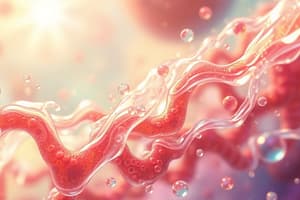Podcast
Questions and Answers
Which statement correctly describes the relationship between acids and their conjugate bases?
Which statement correctly describes the relationship between acids and their conjugate bases?
- Stronger acids have stronger conjugate bases.
- Weaker acids have stronger conjugate bases.
- Stronger acids have weaker conjugate bases. (correct)
- Conjugate bases have no relation to acid strength.
What is the implication of a higher pKa value in a conjugate acid?
What is the implication of a higher pKa value in a conjugate acid?
- The acid is neutral.
- The acid is stronger.
- The conjugate base is weaker.
- The conjugate base is stronger. (correct)
In acid-base reactions, which species is favored at equilibrium?
In acid-base reactions, which species is favored at equilibrium?
- The weaker acid and the weaker base. (correct)
- The stronger acid and the stronger base.
- The weaker acid and the stronger base.
- The stronger acid and the weaker base.
Based on pKa values, which of the following pairs correctly identifies the stronger base?
Based on pKa values, which of the following pairs correctly identifies the stronger base?
What can be inferred about the water solubility of carboxylic acids with more than five carbon atoms?
What can be inferred about the water solubility of carboxylic acids with more than five carbon atoms?
Which of the following bases is classified as a strong base based on its comparative pKa value?
Which of the following bases is classified as a strong base based on its comparative pKa value?
Which statement about the solubility of NaOH and amines is correct?
Which statement about the solubility of NaOH and amines is correct?
What trend is observed in the acidity of hydrogen halides as their bond strength changes?
What trend is observed in the acidity of hydrogen halides as their bond strength changes?
Which hydrogen halide has the strongest bond and thus the weakest acid?
Which hydrogen halide has the strongest bond and thus the weakest acid?
Which of the following correctly states the relationship between acidity and molecular structure as we move down a group in the Periodic Table?
Which of the following correctly states the relationship between acidity and molecular structure as we move down a group in the Periodic Table?
Which statement about the solubility of amines in aqueous acids is true?
Which statement about the solubility of amines in aqueous acids is true?
Which of the following represents the correct relationship between electronegativity and charge acquisition of an atom?
Which of the following represents the correct relationship between electronegativity and charge acquisition of an atom?
Considering the provided bond lengths and pKa values, which hydrogen halide exhibits the highest pKa, indicating the lowest acidity?
Considering the provided bond lengths and pKa values, which hydrogen halide exhibits the highest pKa, indicating the lowest acidity?
What happens to the acidity of hydrogen halides as their bond lengths increase?
What happens to the acidity of hydrogen halides as their bond lengths increase?
Which of the following correctly ranks the hydrogen halides by increasing acidity?
Which of the following correctly ranks the hydrogen halides by increasing acidity?
What best describes the inductive effect of fluorine on the carbon atom it is bonded to?
What best describes the inductive effect of fluorine on the carbon atom it is bonded to?
When comparing the acidity of acetic acid and ethanol, what is the primary factor for their difference in acidity?
When comparing the acidity of acetic acid and ethanol, what is the primary factor for their difference in acidity?
Which factor contributes to the resonance stabilization of acetate compared to ethoxide?
Which factor contributes to the resonance stabilization of acetate compared to ethoxide?
Which of the following statements about inductive effects is incorrect?
Which of the following statements about inductive effects is incorrect?
What is a key characteristic of carbocations?
What is a key characteristic of carbocations?
Why is acetic acid a stronger acid than ethanol based on their respective pKa values?
Why is acetic acid a stronger acid than ethanol based on their respective pKa values?
An electrophile is defined as a reagent that:
An electrophile is defined as a reagent that:
Which statement correctly describes carbanions?
Which statement correctly describes carbanions?
Which statement about the distance and inductive effects is accurate?
Which statement about the distance and inductive effects is accurate?
How does the structure of acetic acid contribute to its acidity compared to ethanol?
How does the structure of acetic acid contribute to its acidity compared to ethanol?
What is the relationship between Lewis acids and electrophiles?
What is the relationship between Lewis acids and electrophiles?
What role does electron delocalization play in the stability of conjugate bases?
What role does electron delocalization play in the stability of conjugate bases?
What is true regarding the dissociation of bonds in heterolysis?
What is true regarding the dissociation of bonds in heterolysis?
What role do carbocations play in chemical reactions?
What role do carbocations play in chemical reactions?
What is the relationship between pKa and acid strength?
What is the relationship between pKa and acid strength?
Which of the following is a true statement regarding the acidity of acetic acid and ethanol?
Which of the following is a true statement regarding the acidity of acetic acid and ethanol?
How do carbon atoms, which are electron poor due to bond polarity but are not carbocations, behave?
How do carbon atoms, which are electron poor due to bond polarity but are not carbocations, behave?
What is the distinguishing feature of a nucleophile?
What is the distinguishing feature of a nucleophile?
What happens during the heterolytic cleavage of a bond?
What happens during the heterolytic cleavage of a bond?
What defines a Lewis acid in the context of carbocations?
What defines a Lewis acid in the context of carbocations?
What is the relationship between Ka and the strength of an acid?
What is the relationship between Ka and the strength of an acid?
At 25°C, the acidity constant for acetic acid is given as 1.76 x 10−5. What can be inferred about acetic acid based on this value?
At 25°C, the acidity constant for acetic acid is given as 1.76 x 10−5. What can be inferred about acetic acid based on this value?
What is the equilibrium expression for the dissociation of a generic weak acid HA in water?
What is the equilibrium expression for the dissociation of a generic weak acid HA in water?
In a 0.1 M solution of acetic acid, approximately what percentage of molecules ionize at 25°C?
In a 0.1 M solution of acetic acid, approximately what percentage of molecules ionize at 25°C?
What happens to the value of Ka if the concentration of a weak acid in solution is increased?
What happens to the value of Ka if the concentration of a weak acid in solution is increased?
For which of the following acids would you expect the largest value of Ka?
For which of the following acids would you expect the largest value of Ka?
Which of the following best describes a weak acid?
Which of the following best describes a weak acid?
What is the equivalent expression for the acidity constant (Ka) derived from Keq for a weak acid?
What is the equivalent expression for the acidity constant (Ka) derived from Keq for a weak acid?
Why is acetic acid considered a weak acid compared to strong acids like HCl?
Why is acetic acid considered a weak acid compared to strong acids like HCl?
What characterizes the equilibrium constant (Keq) in the context of weak acid dissociation?
What characterizes the equilibrium constant (Keq) in the context of weak acid dissociation?
Flashcards are hidden until you start studying
Study Notes
Acidity and Basicity
- Carboxylic acids with more than 5 carbons are insoluble in water.
- Carboxylic acids become soluble in water due to their polarity when they form salts in reaction with NaOH (sodium hydroxide).
- Amines with high molecular weights are also insoluble in water.
- Amines are basic and will form salts with aqueous acids.
Structure and Acidity
- The strength of the H-X bond determines the strength of the acid. H-F, H-Cl, H-Br, and H-I.
- Stronger bond = weaker acid.
- Acidity increases going down a group in the periodic table.
- Higher electronegativity of an atom makes it easier to acquire a negative charge.
- Inductive effects are electronic effects transmitted through the bonds of molecules.
- Inductive effects can be electron donating or electron withdrawing.
- Strength of inductive effects decrease with distance.
Acidity: Carboxylic Acids vs. Alcohols
- Carboxylic acids are more acidic than alcohols.
- Acetic acid is more acidic than ethanol.
- The pKa value of acetic acid is 4.75.
- The pKa value of ethanol is 16.
- The stronger the acid, the weaker the conjugate base.
The Effect of Delocalization
- The conjugate base of acetate is more stable than the conjugate base of ethoxide due to resonance stabilization.
- This resonance stabilization is what makes acetate a stronger acid than ethanol.
The Inductive Effect
- The inductive effect is a stabilizing effect in which an electron-withdrawing group like fluorine increases the acidity of a compound.
Heterolysis of Bonds to Carbon: Carbocations and Carbanions
- Heterolysis is a type of bond cleavage involving the breaking of a bond where both electrons go to a single atom.
- Carbocations are electron-deficient as they have only 6 electrons in their valence shell.
- Carbocations are Lewis acids.
Electrophiles and Nucleophiles
- Carbocations are electrophiles because they are electron-seeking molecules.
- Electrophiles are reagents that seek out electron pairs to achieve a stable octet.
- Carbocations are Lewis acids and electrophiles.
- Carbanions are Lewis bases.
- A nucleophile is a Lewis base that seeks a positive center, such as a positively charged carbon atom.
The Strength of Brønsted-Lowry Acids and Bases
- Strong acids such as HCl and H2SO4 fully dissociate in solution while weak acids such as acetic acid only partially dissociate.
- Acetic acid is a weak acid with an acidity constant (Ka) of 1.76 x 10^-5.
- Acids with large Ka values are strong acids.
- Acids with small Ka values are weak acids.
- pKa is used to predict the relative strength of bases.
- Stronger acids have weaker conjugate bases.
- The larger the pKa of a compound the stronger the base.
Predicting the Outcome of Acid-Base Reactions
- Acid-base reactions favor the formation of the weaker acid and weaker base.
- Acid-base reactions follow equilibrium control.
- Reactions following equilibrium control favor the formation of the most stable species (lowest potential energy).
- Water solubility is determined by the formation of salts.
Studying That Suits You
Use AI to generate personalized quizzes and flashcards to suit your learning preferences.





